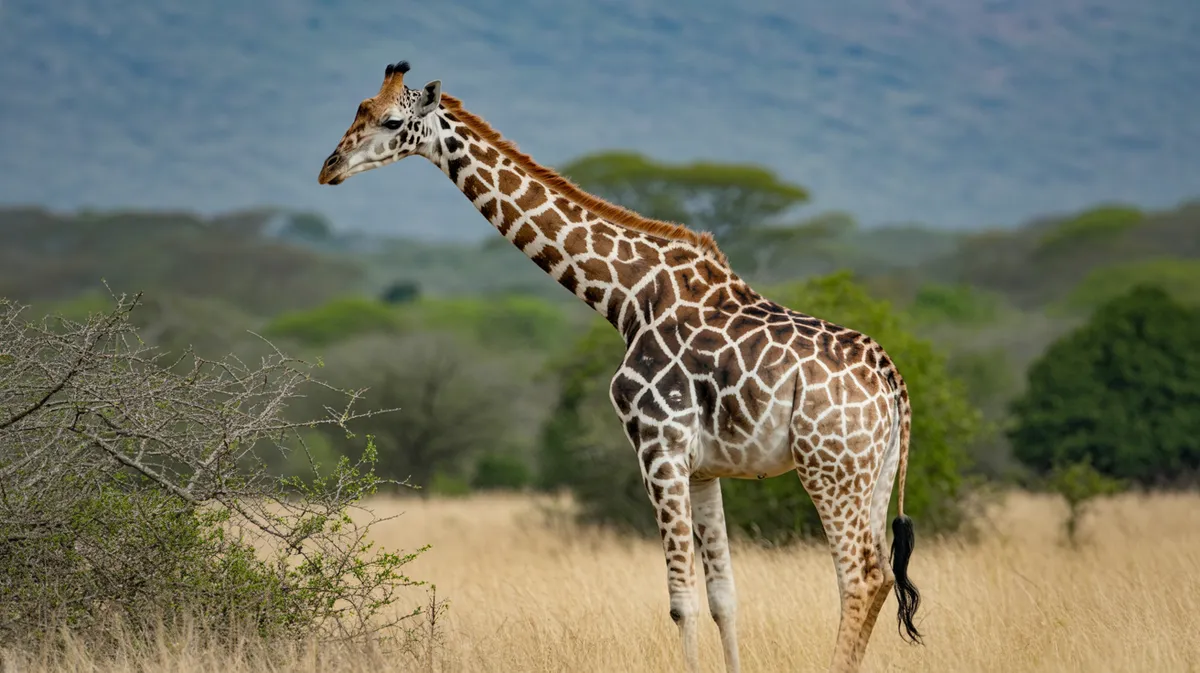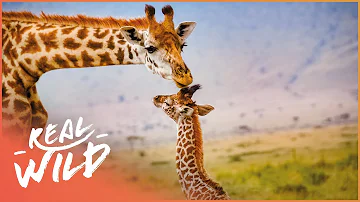
Giraffe
Giraffa camelopardalis

Meet the Giraffe
The giraffe is the world's tallest land animal, easily recognized by its extremely long neck and legs, as well as its distinctive spotted coat. Native to the savannas and open woodlands of sub-Saharan Africa, giraffes use their height to browse leaves and shoots high up in trees, especially from acacias. Their long, prehensile tongues help them strip leaves from thorny branches. Giraffes live in loosely structured herds and communicate using a variety of vocalizations and body language. Despite their size and height, they are surprisingly graceful and capable of running at speeds up to 35 miles per hour.
Classification
Mammal
Habitat
Savanna and open woodland
Diet
Herbivore
Lifespan
20-25 years
Conservation
Vulnerable
Weight
800-1,200 kg (1,760-2,650 lbs)
📖Fascinating Facts
Tallest Land Animal
Adult male giraffes can reach heights of up to 5.5 meters (18 feet), making them the tallest animals on Earth.
Long, Prehensile Tongue
Giraffes use their 45 cm (18 in) long tongues to grasp and pull leaves from thorny trees, particularly acacias.
Unique Gait
Giraffes walk by moving both legs on the same side of their body at once, known as 'pacing gait,' which is uncommon among large mammals.
📋Detailed Description
The giraffe (Giraffa camelopardalis) is a highly specialized ruminant mammal, instantly recognizable by its exceptionally long neck, which can measure up to 2.4 meters (8 feet) and contains only seven elongated cervical vertebrae—the same number as most mammals. Adult males (bulls) can reach heights of 5.5–6 meters (18–20 feet) and weigh between 1,200–1,930 kg (2,600–4,250 lbs), while females (cows) are generally smaller. Their distinctive coat patterns, composed of polygonal patches separated by light-colored lines, are unique to each individual and serve as camouflage in the dappled light of their savanna habitats. Giraffes possess large, prehensile tongues (up to 45 cm/18 inches) and tough lips, adaptations that allow them to feed efficiently on thorny acacia trees. Their cardiovascular system is remarkable, with a powerful heart (weighing up to 11 kg/25 lbs) and specialized blood vessels to manage the high blood pressure required to pump blood up their long necks. Giraffes are diurnal and crepuscular, spending much of their day browsing and ruminating. They have excellent vision and hearing, which, combined with their height, make them effective sentinels for other herbivores. Socially, giraffes form loose, open herds with fluid membership, and males often engage in 'necking' battles to establish dominance. Females give birth standing up, resulting in a dramatic drop for the newborn calf, which is able to stand and walk within an hour. Giraffes are generally silent but can produce a range of vocalizations, including grunts, snorts, hisses, and infrasonic sounds.
💡 Did you know?
A giraffe's heart is about 60 cm (2 feet) long and weighs up to 11 kg (25 lbs) to pump blood all the way to its brain.
🔬Research & Sources
Wikipedia Summary
The giraffe is a large African hoofed mammal belonging to the genus Giraffa. It is the tallest living terrestrial animal and the largest ruminant on Earth. Traditionally, giraffes have been thought of as one species, Giraffa camelopardalis, with nine subspecies. Most recently, researchers proposed dividing them into four extant species due to new research into their mitochondrial and nuclear DNA, and individual species can be distinguished by their fur coat patterns. Six valid extinct species of Giraffa from Africa and Pakistan are known from the fossil record.
Last Modified: 6/10/2025
🎭Behavior & Social Structure
Giraffes are predominantly browsers, feeding on leaves, flowers, and fruits from a variety of trees and shrubs, with a strong preference for acacias. They spend up to 16–20 hours per day feeding and ruminating, consuming approximately 34 kg (75 lbs) of foliage daily. Their social structure is highly fluid; groups may consist of a few individuals to over 20, with composition changing frequently. Females and their young form nursery groups, while males are more solitary or form bachelor herds. Males engage in ritualized combat known as 'necking,' where they swing their heads and necks to deliver powerful blows, establishing social hierarchies and breeding rights. Giraffes are vigilant and use their height to scan for predators, often serving as early warning systems for other animals. They sleep very little—usually less than two hours per day, often in short bouts while standing. Drinking is a vulnerable activity, requiring them to splay their legs and lower their necks, making them susceptible to predation by lions and crocodiles.
👶Reproduction & Life Cycle
Giraffes are non-seasonal breeders, though births may peak during the rainy season in some regions. Males detect females in estrus using the flehmen response, curling their lips to analyze pheromones in female urine. After a gestation period of about 15 months, females give birth to a single calf (rarely twins), which stands approximately 1.8 meters (6 feet) tall at birth and weighs 50–70 kg (110–150 lbs). Calving typically occurs while the female is standing, and the calf drops about 1.5 meters (5 feet) to the ground. Newborns can stand and walk within an hour, a crucial adaptation for predator avoidance. Mothers are highly attentive, hiding their calves in vegetation for the first few weeks and returning to nurse them several times a day. Weaning occurs at 12–16 months, but calves may remain with their mothers for up to two years. Sexual maturity is reached at 3–4 years for females and 4–5 years for males, though males may not breed until they are older and have established dominance.
🛡️Adaptations & Survival
Giraffes exhibit a suite of remarkable adaptations for their browsing lifestyle and large size. Their elongated necks and legs allow access to food sources unavailable to other herbivores, reducing competition. The prehensile tongue and tough oral tissues enable them to feed on thorny plants. Their cardiovascular system includes a large, powerful heart and specialized valves in the jugular veins to prevent blood pooling or sudden pressure changes when raising or lowering the head. Giraffes have a unique gait called 'pacing,' moving both legs on one side of the body simultaneously, which aids in stability. Their spotted coat provides camouflage, and their acute vision and elevated vantage point enhance predator detection. Socially, their flexible group structure allows them to adapt to changing environmental conditions and predation pressures.
📚Research Sources
🎨Cultural Significance
Giraffes have long held a place in African folklore, art, and mythology, often symbolizing grace, intuition, and farsightedness. Ancient Egyptians depicted giraffes in tomb paintings, and their tails were historically used as fly whisks or symbols of authority. In modern times, giraffes are popular in zoos and wildlife tourism, serving as ambassadors for African wildlife conservation. Their unique appearance has inspired numerous cultural references, from children's literature to corporate logos. Some indigenous groups have traditional beliefs or taboos associated with giraffes, and their body parts have occasionally been used in traditional medicine.
🔬Recent Research & Discoveries
Recent genetic studies have challenged the traditional view of a single giraffe species with multiple subspecies, instead supporting the recognition of four distinct species: the northern giraffe (G. camelopardalis), southern giraffe (G. giraffa), Masai giraffe (G. tippelskirchi), and reticulated giraffe (G. reticulata). These findings have significant implications for conservation management and prioritization. Ongoing research focuses on giraffe vocalizations, including the discovery of infrasonic communication, and the biomechanics of their necks and cardiovascular systems. Studies on giraffe skin disease and its impact on populations are also underway. Satellite tracking and genetic monitoring are increasingly used to inform conservation strategies and understand movement patterns across fragmented landscapes.
🎥Wildlife Videos

Giraffes: The Forgotten Giants (2014) | Full Documentary
An exciting look at scientist trying to solve the last pieces of code about how giraffes communicate. Meet giraffes living in the wild ...
PBS America

Graceful Giants - GIRAFFES Documentary Film in 4K UHD - Incredible Wildlife of Africa
Incredible Wildlife of Africa - GIRAFFES, the Tallest Animals in the World is a stunning 4K documentary film that takes you on an ...
4K Relaxation Channel

Giraffes 101 | Nat Geo Wild
How fast do baby giraffes grow? How many vertebrae are in that long neck? A truly unique species, giraffes are found only in ...
Nat Geo Animals

African Safari 4K • Wildlife Relaxation Film | Nature 4K Ultra HD
Wildlife Animals on Safari. House of animals like lions‚ rhinos‚ cheetahs‚ giraffes‚ antelope, hippos, leopards, zebras‚ and ...
Relaxation Film
![[NEW/IMPROVED] All About Giraffes for Kids: Giraffe Video for Children - FreeSchool](https://i.ytimg.com/vi/1Uj2r-8DjG4/hq720.jpg?sqp=-oaymwEcCOgCEMoBSFXyq4qpAw4IARUAAIhCGAFwAcABBg==&rs=AOn4CLAAmceiy4YeqC-MOcsfkMiadZ_qKw)
[NEW/IMPROVED] All About Giraffes for Kids: Giraffe Video for Children - FreeSchool
At up to 18 feet tall, giraffes are bigger than a double decker bus. They are the tallest land animals on earth and are native to ...
Free School

Giraffes: Africa's Majestic Herbivores | Wildlife Quest
We follow several giraffes and their babies as they wander through the bush in Kwazulu-Natal. See how these beautiful animals ...
Real Wild
🌍Habitat Information
The Giraffe typically inhabits Savanna and open woodland environments. Giraffes have adapted to their environments with specialized features and behaviors.
Primary Habitat:
Savanna and open woodland
More detailed habitat information will be available soon.
🛡️Conservation Status
The Giraffe is currently classified as Vulnerable. Conservation efforts are crucial for preserving this species for future generations.
Common Threats:
- 🏠Habitat loss and fragmentation
- 🌡️Climate change impacts
- 🎯Hunting and poaching
- 🏭Human-wildlife conflict
⚠️Threats & Conservation Challenges
Giraffe populations have declined by approximately 40% over the past three decades, primarily due to habitat loss, fragmentation, and degradation from agricultural expansion, human settlement, and infrastructure development. Illegal hunting (poaching) for meat, hides, and traditional medicine also poses significant threats. Civil unrest and armed conflict in parts of Africa have exacerbated declines in some regions. Giraffes are listed as 'Vulnerable' on the IUCN Red List, with some populations, such as the West African giraffe (Giraffa peralta), classified as 'Endangered.' Climate change, disease outbreaks (e.g., giraffe skin disease), and competition with livestock further challenge their survival. Conservation efforts include habitat protection, anti-poaching measures, translocations, and community-based programs.
🔬Scientific Classification
Scientific Name
Giraffa camelopardalis
Classification Hierarchy
🔍 About Taxonomic Classification
Taxonomic classification is a hierarchical system used by scientists to classify and organize living organisms based on shared characteristics and evolutionary relationships.
The system moves from broad categories (Kingdom) to increasingly specific ones, with each animal's scientific name typically consisting of its Genus and species.
📝Community Notes
Share your observations and insights about the Giraffe with our community of wildlife enthusiasts.
Join Our Community
Sign in to share your observations and connect with fellow wildlife enthusiasts.
Sign In to ContributeNo community notes yet
Be the first to share your observations about the Giraffe!
Explore Giraffe
Select a tab above to learn more about this amazing animal.
📸Photo Gallery
No photos available for this animal yet.
🌟Discover More Wildlife
Continue your journey of discovery with more fascinating animals from our database
